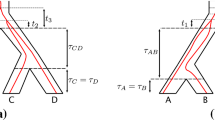Abstract
Distances between sequences based on their k-mer frequency counts can be used to reconstruct phylogenies without first computing a sequence alignment. Past work has shown that effective use of k-mer methods depends on (1) model-based corrections to distances based on k-mers and (2) breaking long sequences into blocks to obtain repeated trials from the sequence-generating process. Good performance of such methods is based on having many high-quality blocks with many homologous sites, which can be problematic to guarantee a priori. Nature provides natural blocks of sequences into homologous regions—namely, the genes. However, directly using past work in this setting is problematic because of possible discordance between different gene trees and the underlying species tree. Using the multispecies coalescent model as a basis, we derive model-based moment formulas that involve the species divergence times and the coalescent parameters. From this setting, we prove identifiability results for the tree and branch length parameters under the Jukes–Cantor model of sequence mutations.


Similar content being viewed by others
References
Allman ES, Degnan JH, Rhodes JA (2011) Determining species tree topologies from clade probabilities under the coalescent. J Theor Biol 289:96–106
Allman ES, Rhodes JA, Sullivant S (2017) Statistically consistent k-mer methods for phylogenetic tree reconstruction. J Comput Biol 24(2):153–171
Blackshields G, Sievers F, Shi W, Wilm A, Higgins DG (2010) Sequence embedding for fast construction of guide trees for multiple sequence alignment. Algorithms Mol Biol 5:21
Cox DA, Little J, O’Shea D (2015) Ideals, varieties, and algorithms. Undergraduate Texts in Mathematics. Springer, Cham, fourth edition, An introduction to computational algebraic geometry and commutative algebra
Dasarathy G, Nowak R, Roch S (2015) Data requirement for phylogenetic inference from multiple loci: A new distance method. IEEE/ACM Trans Comput Biol Bioinf 12:422–432
Daskalakis C, Roch S (2013) Alignment-free phylogenetic reconstruction: sample complexity via a branching process analysis. Ann Appl Probab 23:693–721
Edgar RC (2004a) MUSCLE: a multiple sequence alignment method with reduced time and space complexity. BMC Bioinf 5:113
Edgar RC (2004b) MUSCLE: multiple sequence alignment with high accuracy and high throughput. Nucleic Acids Res 32:1792–1797
Gale D, Nikaido H (1965) The Jacobian matrix and global univalence of mappings. Math Ann 159(2):81–93
Kingman JFC (1982) The coalescent. Stoch Process Their Appl 13(3):235–248
Leung D, Drton M, Hara H et al (2016) Identifiability of directed Gaussian graphical models with one latent source. Electron J Stat 10(1):394–422
McVean GAT (2002) A genealogical interpretation of linkage disequilibrium. Genetics 162(2):987–991
Pamilo P, Nei M (1988) Relationships between gene trees and species trees. Mol Biol Evol 5(5):568–583
Rannala B, Yang Z (2003) Bayes estimation of species divergence times and ancestral population sizes using dna sequences from multiple loci. Genetics 164(4):1645–1656
Semple C, Steel M (2003) Phylogenetics, volume 24 of Oxford lecture series in mathematics and its applications. Oxford University Press, Oxford
Sievers F, Wilm A, Dineen DG, Gibson TJ, Karplus K, Li W, Lopez R, McWilliam H, Remmert M, Söding J, Thompson JD, Higgins DG (2011) Fast, scalable generation of high-quality protein multiple sequence alignments using Clustal Omega. Mol Syst Biol 7:539
Speyer D, Sturmfels B (2004) The tropical Grassmannian. Adv Geom 4(3):389–411
Takahata N (1986) An attempt to estimate the effective size of the ancestral species common to two extant species from which homologous genes are sequenced. Genet Res 48(03):187–190
Takahata N, Satta Y, Klein J (1995) Divergence time and population size in the lineage leading to modern humans. Theor Popul Biol 48(2):198–221
Wakeley J (2009) Coalescent theory: an introduction, vol 1. Roberts & Company Publishers Greenwood Village, Colorado
Acknowledgements
Chris Durden was partially supported by the US National Science Foundation (DMS 1615660). Seth Sullivant was partially supported by the US National Science Foundation (DMS 1615660) and by the David and Lucille Packard Foundation.
Author information
Authors and Affiliations
Corresponding author
Rights and permissions
About this article
Cite this article
Durden, C., Sullivant, S. Identifiability of Phylogenetic Parameters from k-mer Data Under the Coalescent. Bull Math Biol 81, 431–451 (2019). https://doi.org/10.1007/s11538-018-0399-1
Received:
Accepted:
Published:
Issue Date:
DOI: https://doi.org/10.1007/s11538-018-0399-1




